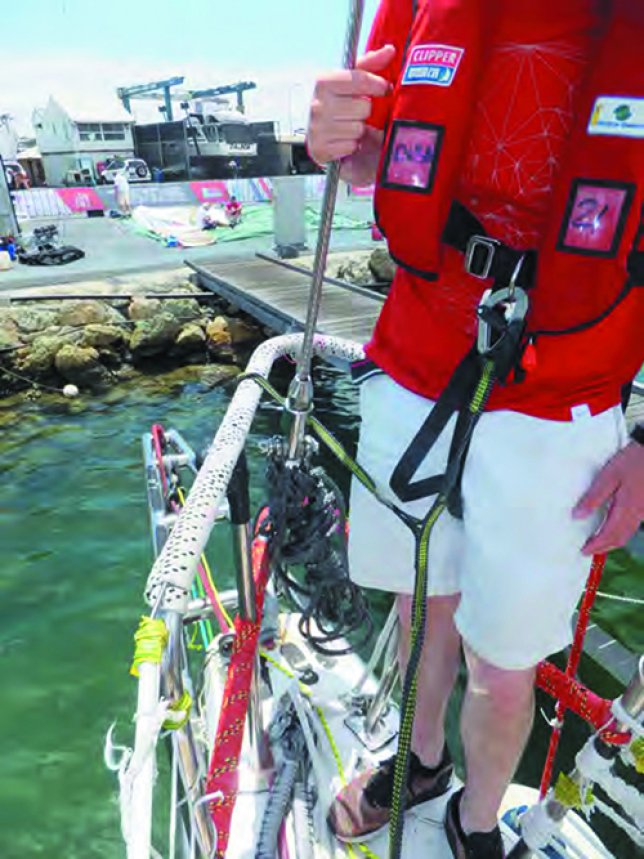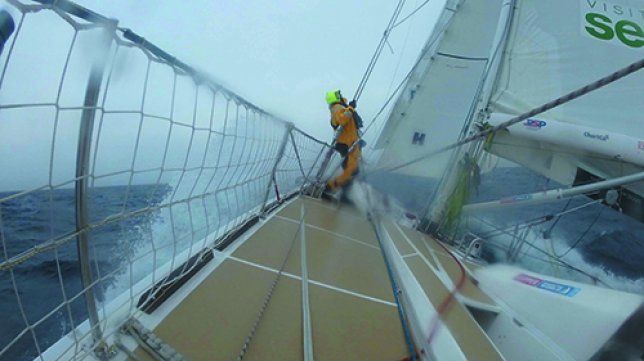On November 18, 2017, Simon Speirs was washed off the bow of Clipper 70 CV30 during a southern ocean leg of the Clipper Around the World Race. He was attached to the boat with a 2-meter tether, which initially held him but failed within a few minutes. He was recovered 32 minutes later, but he could not be resuscitated.
In PS Safety Tethers Under Scrutiny March 2018 we reported on the tether clip that failed, comparing it through testing to both the applicable standards and other tether clips that were on the market at the time. We found considerable deficiencies in the type of tether clips Speirs had relied on. The British Marine Accident Investigation Board (MAIB) issued their final report on June 20, 2019, which raised questions about the design, maintenance, and operation of all Clipper Ventures boats. Our recent report looked at gaps in the MOB recovery procedure (see Rethinking the MOB Recovery, PS September 2019) What follows relates only to tether and jackline findings.
Root Cause
The carabiner on the end of Speirs tether became lodged under a cleat, the combined result of terminating a jackline at a cleat and having slack in the jackline. It seems he had clipped his primary and only active tether leg onto a secondary jackline installed under the guidance of the skipper and only intended for use with the secondary, short tether, as a safer alternative to clipping the lifeline or pulpit. Second, the jackline was slack because one of the stanchion bases it was attached to had been damaged. This allowed the clip to slide into a truly awful position, exposing it to leverage it could not withstand.
Solutions
There are many solutions, and the more of these corrective measures you adopt, the better the odds of never encountering this or a related failure.

- Snug jacklines. If the jackline is tight, the potential for a clip remaining jammed under the cleat is much less. The presence of a secondary jackline per se was not fatal, but the fact that it was slack was.
- Eliminate clip jams. After the accident, Clipper Ventures wrapped lines around the cleats, filling the area under the horns so the clip could not jam. That can work and we recommend it for jacklines terminating at cleats. Also consider pinch points along the jackline path, remembering that the jackline will be deflected as much as several feet to the side under load.
- Dedicated jackline padeyes. We favor terminating jacklines at padeyes or bolt hangers for several reasons. Dedicated locations can be optimally located rather than dictated by cleat placement. Dedicated anchors can be located to avoid snagging and cross loading potential. And for cruisers, dedicated anchors leave the cleats free for other purposes. It seems silly not to install permanent fixtures for gear that must function in adverse conditions.
- New Tether Clip Standard. The UIAA 121 standard for carabiners and clips used by alpinists and climbers includes a type K connector, originally designed for via ferrata climbing. It is tested to withstand side forces considerably greater than those generated during Speirs accident. In our view, a type K carabiner would have survived undamaged.
The Kong Tango, used in many tether sets, including the Spinlock Performance series, Glowfast, and Kongs own line of tethers, is a popular, inexpensive clip proven in over more than a decade of marine use. They are lighter, cheaper, easier to use with one hand or gloves, and open wide enough to clip 1-inch tubing.
- Use carabiners that meet UIAA 121 standards for accidental opening of locking connectors. Practical Sailor tested Spinlock race hooks on the standard test rig and found the accidental opening force to be as low as 6 pounds (see PS March 2018). MAIB also observed accidental opening, although they did not report the required force or attach any test report
The ISO 12401 standard governing safety tethers does not specify an accidental opening force, but to our minds, 6 pounds is a barely noticeable nudge against a tether. The MAIB recommended that accidental opening force be clarified in the standard, but did not recommend a value. Under UIAA 121, locking carabiners must withstand 275 pounds directly against the gate. Curiously, MAIB concluded that a standard that addresses these serious shortcomings would be difficult to develop:
It would be difficult to develop a standard for safety tethers that ensured hooks could not be opened accidentally and would withstand all possible loading scenarios. The design of a safety hook inevitably will be a balance between strength, weight and ease of operation using one hand . . . Various designs of tether hooks are available in the marine sector, each with their advantages and disadvantages.
In fact, the UIAA standards to prevent accidental opening have existed for 30 years and there are products that have successfully passed the test of time. Period.
Conclusions
Read the full report. This article has only touched on a few of the many safety issues described in the full document. Also, be sure to read the Clipper Ventures response (excerpted above), in which they present their side of the story. In addition to modifying our recovery procedures, we are using UIAA type K carabiners on our boats (see Safety Tethers Under Scrutiny, PS March 2018).






































